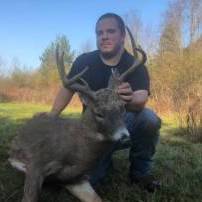-
Similar Content
-
By Francesco B
Hello everyone I’m currently looking at a house in deposit ny I’ve been deer hunting for many year mainly in Columbia and Greene county never been to Broome county. Before anything I was just curious how is the hunting there ? I know there aren’t any antlered restrictions in Broome but are there monsters out there or is it mainly just small spike? If anyone from that county or knows about deposit and broome county would get back to me i would appreciate it. Hope everyone hunting today catch a big one thanks.
-
By Ainsley Ash
The procedure below to carry the bow is detailed below:
You have to use a cotton towel or something similar. You have to wrap it around the bowstring. Doing so ensures that it will not cause an injury with the bowstring coming in contact with your body. It will not be that sharp either. Once you cover the bowstring with the towel, you have to wear it like a sling. So that it will not fall away from your body. The best way to cover the bowstring is to use a large enough towel. You can wrap it around twice as well. When making a sling out of the cotton towel, you have to ensure that you tighten it to get a snug fit. In that case, it will not slip away. Consequently, it will remain in place. When using this technique to carry a bow on your back, it is essential to practice before going in the wilderness. Only when you can move briskly and without noise using the scanning mechanism should you go ahead with it. To remove the bow, you have to hold it at the bottom. After that, you have to slip it over your head as well as arm. Doing so ensures that you can remove it quickly. When trying to focus on a prey, you need to remove the bow quickly. The technique for removal that we have highlighted above can certainly help you do so.
-
By JDN2K
Just want to relay an experience I had this weekend regarding hunting regulations and other hunters.
I've had several hunter's tell me last weekend(10/12/2020) that muzzleloader was open, it is not. I also had two other hunters last weekend confront me as to why my son was carrying around a rifle and hunting deer. I calmly explained the youth weekend and the rules around it. After that everything was cool and we continued our hunt.
I know at the end of the day we're all trying to participate in a sport we love and maybe harvest some game. My thought is to just make sure you're up on your local hunting regulations. Not just so you are within the rules, but also so you can assert your right to be where you are, hunting the way you're hunting.
I know when I have been operating outside of the regulations I have appreciated a person respectfully correcting my ignorance and I try to pay it forward by being informed and respectfully educating when required.
Thanks for listening, off my SB...
-
By Alfredo
Hello,
I am in the process of purchasing my first rifle to go hunting deer for the first time. However, I have received contradicting information regarding the types of rifles that are legal. Based on what I have read, it appears that I am able to use a bolt-action rifle with a pistol grip and a detachable magazine which holds 10 rounds. However, I have been told that this is not the case. I can't seem to find where this is stated. Can any one here provide me with some insight into this? I'd really appreciate it.
Thanks in Advanced,
Alfredo
-
By RJ_Outdoor_Experience
Newest Hunting Podcast called The Young American Hunter has now published its first episode. Lead by Ryan & Jake- the moderators of @rj_outdoor_exeprience on Instagram. Both Ryan and Jake are avid outdoorsmen and have been around hunting their entire lives. Learning from the young and the old, Ryan and Jake bring their experiences straight to you. On the first episode of The Young American Hunter podcast, Jake provides a brief introduction and explains the purpose of the show. Ryan will be joining in on future episodes. To listen to the episode, copy and paste the link below into your web browser. Here is the bio for Jake's introduction:
"Thank you for joining us for our FIRST ever hunting podcast here on the Young American Hunter podcast. As you may have already heard, this podcast is gauged towards the new hunters trying to get out in the woods. The Young American Hunter podcast is here to entertain the hunting population, educate upcoming hunters, provide product reviews and discuss some of the newest Wildlife Management Laws. This episode is broadcasted by Jake (Big Haas). Ryan (Rooster) will be joining us in the following episodes. As time goes on and the more episodes that are being published, we promise you it will be more entertaining. This episode is just an introduction... We cant wait to bring more to you! Follow our virtual journal on Instagram (@rj_outoor_experience) and engage in some of the feeds we post! We look forward to hearing from you and enjoy the show! Thank you for joining us for our FIRST ever hunting podcast here on the Young American Hunter podcast. As you may have already heard, this podcast is gauged towards the new hunters trying to get out in the woods. The Young American Hunter podcast is here to entertain the hunting population, educate upcoming hunters, provide product reviews and discuss some of the newest Wildlife Management Laws. This episode is broadcasted by Jake (Big Haas). Ryan (Rooster) will be joining us in the following episodes. As time goes on and the more episodes that are being published, we promise you it will be more entertaining. This episode is just an introduction... We cant wait to bring more to you! Follow our virtual journal on Instagram (@rj_outoor_experience) and engage in some of the feeds we post! We look forward to hearing from you and enjoy the show!"
"FYI... Future podcasts will be longer! this was a basic overview of Jakes's hunting background. We hope you enjoyed it... God Bless America"
Link: https://anchor.fm/youngamericanhunter
FOLLOW: @rj_outdoor_experience on Instagram
-
-
Recently Browsing 0 members
No registered users viewing this page.






Recommended Posts
Join the conversation
You can post now and register later. If you have an account, sign in now to post with your account.